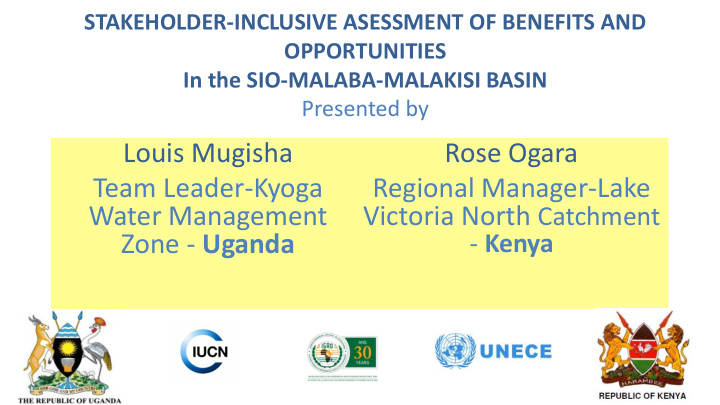



STAKEHOLDER-INCLUSIVE ASESSMENT OF BENEFITS AND OPPORTUNITIES In the SIO-MALABA-MALAKISI BASIN Presented by Louis Mugisha Rose Ogara Team Leader-Kyoga Regional Manager-Lake Water Management Victoria North Catchment Zone - Uganda - Kenya
Sio Malaba Malakisi Basin The Sio-Malaba-Malakisi (SMM) River Basin is shared by Kenya and Uganda. All the rivers originate from Mt Elgon- combined catchment area => 3240 square kilometers. Total combined population=> about 4million people 80% of are engaged in rain-fed agriculture Rainfall- Mt Elgon areas =>1800mm, Lowlands(Butaleja and Iganga)=> 900mm- 1180mm Good climatic conditions contribute to an ecosystem rich in fauna and flora Poverty is very high(30%-66%); many of the rural population struggle to meet their basic needs
Basin issues Pollution and poor solid waste management: breeding grounds for flies and other vectors that cause disease. surface water and groundwater pollution by leachate, impairment of soil permeability, and blockage of drainage Flooding: affects both people and property High population growth (2% to 5% rate): land fragmentation and farming in marginal areas causing soil erosion and nutrient loss. Weak enforcement of environmental management regulations Weak law enforcement institutions Increase in water- and land-related conflicts
18 Confirmed Dead, 450 Buried After Bududa Landslide Posted on June 26, 2012
Stakeholder-inclusive Interventions in SMM under the Nile Basin Initiative A number of environmental management activities were implemented and water related investment opportunities identified, e.g.: • SCMPs: Developed 10 trans boundary Sub Catchment Management Plans ( SCMPs). • Hydromet stations: Installed 20 Transboundary Hydromet stations
BENEFITS and opportunities from cooperation in the SMM basin Economic Benefits Increased activity, productivity and long-term sustainability in economic sectors (aquaculture, irrigated agriculture, energy generation, nature-based tourism) Employment in agro based industries Ecosystem Benefits Preservation of aquatic and terrestrial habitats and biodiversity Inter-generational sustainability of ecosystems and natural infrastructure Social Benefits Improved water quality and reduced risk of water-related disaster Social welfare from increased employment and reduced poverty Regional Economic Cooperation Benefits Development of regional markets for goods, services and labor Increase in cross-border investments Development of transnational infrastructure networks (transport, energy) Peace and security benefits Shared basin identity Increased geopolitical stability and strengthened diplomatic relations OPPORTUNITIES IN SMM Basin Monograph Investment Strategy Decision Support System (DSS) Memorandum of Understanding between the riparian states
Benefit Opportunities Assessment • The SMM stakeholders recently engaged in an innovative exercise to maximise benefits across stakeholders through cooperative planning • The aim is to support decisions about investments in water management and development that benefit the most stakeholders in both riparian countries. • This exercise was used in the context of updating the SMM investment strategy and defining priority investments • A shortlist of 12 priority investments had been identified through prior multi-criteria analysis
Benefit Opportunities Assessment Tool (BOAT): Examining Qualitative Impacts on Stakeholders • Water use activities may have positive or negative impacts (externalities) on other water users • A first step consisted of examining the balance of positive and negative impacts from a given project, or set of projects, across different stakeholder groups in a shared basin • Then stakeholders worked together to see how joint changes in water management can enhance benefits for the most stakeholders and both riparian countries? BOAT is a multi-stakeholder dialogue and decision support tool which precedes a more in-depth analytical process to design strong sets of interventions
Preliminary BOAT Matrix SMM
Group work to define the best bundle of projects at sub-basin level • Step 1 Each group analyzed the proposed Boat matrix and proposed changes for each project to reach an agreed starting point • Step 2 : Each group selected which 3 projects to cluster into a “bundle” that could yield the most benefits across stakeholder groups and across Uganda and Kenya, in this sub-basin. • Step 3: Each group worked on their chosen bundle using the BOAT tool to find ways to optimize outcomes for the most stakeholders in the sub-basin, e.g. through alternative/additional measures in project design and/or by substituting projects • Step 4: Once their bundle was finalised, each group summarised the benefits and remaining challenges that this bundle presented
Example of a selected project bundle Group 1bundle consisted of : • Lwakhakha , Chebombai -Catchment Restoration • solid waste management ; • Angolola multi purpose Dam • Community based wetlands • Malakisi SCMP. - Catchment Management & Devt Expected benefits : • Improved WQ & Q, Health, Food security, reduced soil erosion • Whole sub basin management perspective Expected opportunities: • enhance transboundary cooperation • an integrated basin wide approach • The two governments and DPs can choose the bundles relevant for support Expected challenges : Funding the projects.
THANK YOU
Recommend
More recommend